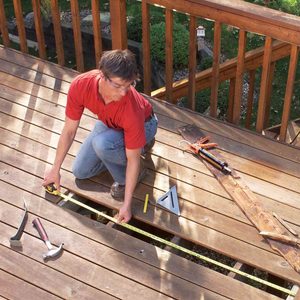Follow This Fall Home-Maintenance Checklist to Keep Your House in Tip-Top Shape
Updated: Dec. 18, 2023

Before you hunker down for the winter, complete this fall home-maintenance checklist to prepare your house for the colder temps
As summer ends and fall peeks around the corner, winter waits in the wings. And this means it’s time to prepare your home for the impending chilly temperatures. While snow-covered towns certainly seem cozy, there’s plenty to do to prepare your house for winter so you’re not shivering the season away in a drafty home. Your fall home-maintenance checklist should include everything from sealing gaps to ward off cold air (and unwanted pests) to insulating pipes so they don’t freeze and then burst. After all, who wants new pests hiding in the attic or burst pipes that wreak havoc on a house?
Of course, it can be hard to come up with a thorough fall home-maintenance checklist. But having the right to-do list for the season will help you identify what key tasks need to be completed before cooler temperatures and snow make home projects even harder. Consider it a fall reset for your house—and you won’t even need to hire a professional organizer or house cleaner to set your home up for success.
To help you create and carry out your fall home-maintenance checklist, we reached out to a dozen home-improvement experts for advice. Read on for a roundup of all the things to do to prepare your home for fall, and get inspired to create your own fall home-maintenance checklist with these expert tips.
Get Reader’s Digest’s Read Up newsletter for more home improvement, humor, cleaning, travel, tech and fun facts all week long.
Drain outdoor faucets and equipment so they don’t freeze
Before severe cold weather sets in, be sure to drain any outdoor equipment that uses water, says Jeff Palla, president of Mr. Handyman. Though this is something every homeowner should check in winter, the task is better done sooner than later.
“Making sure that any outdoor equipment or fixtures—like hoses, sprinklers, pressure washers, etc.—are drained completely will ensure that any remaining water doesn’t freeze with the colder weather,” he says.
Why does that matter? As water freezes, it expands, and that could damage the equipment. Removing the water and preventing freezing can save the equipment and help you avoid spending money on replacing or fixing it.
Insulate pipes to prevent water bursts
Wrap the pipes inside your home to reduce heat loss. Go without, and you risk frozen pipes and the plumbing nightmare that is burst pipes.
“Homeowners can simply use pre-slit pipe foam, heat tape or a thermostatically controlled heat cable to insulate their pipes,” says Palla. “Insulation helps prevent pipes from freezing and potentially bursting, which can lead to costly water damage repairs.”
Seal any gaps to keep cold air out
Nobody wants to spend the winter in a cold, drafty house. Not only is that a chilly prospect, but it’s a surefire way to waste money on energy bills. Thankfully, small actions like sealing windows and cracks can help you save on energy costs. Use caulk or weather stripping to seal any air leaks around pipes, doors, windows, chimneys and electrical outlets, says Steve Leasure, vice president of operations at Rainbow Restoration. And consider installing insulated drapes or shades on windows to prevent drafts. “According to the U.S. Department of Energy, drafts can waste 5% to 30% of your energy use due to air leaks,” he says.
David Flax, president of Window Genie, suggests another step to keeping cold air out: Add a layer of plastic over windows and a draft stopper at the base of doors. The plastic covering can create “a DIY barrier, which will prevent cold drafts from entering the home,” he says. “To help with insulating the door, owners can use a ‘draft snake,’ a long piece of material filled with insulating material, at the bottom of the doors.”
Clean your gutters to prevent pests and water damage
Clogged gutters can lead to significant problems—and in fact, they can be a sneaky sign of pest infestation. “Neglected gutters that are filled with leaves, debris and other things can create improper water drainage, potentially causing costly water damage to the home,” says Flax.
Moreover, he says, standing water that remains in gutters can also lead to rotting, mold and pest infestation. “Worst of all,” he says, “when that standing water freezes in the gutters during the colder months, it can cause ice dams, which are extremely dangerous and can irreversibly damage an owner’s gutters, roof and siding.”
Choose decorative details for inventive heat insulation
Have you heard about thermal wallpaper? Prepare to have your mind blown. “It’s an innovative solution that adds extra insulation to walls by trapping heat and preventing its loss,” says Chantelle Hartman Malarkey, an interior designer and blogger. “Installing it strategically throughout rooms will add warmth during colder seasons.”
While you’re at it, consider installing radiant floor heating too. “Radiant floor heating offers energy-saving luxury by placing heating elements directly beneath the floor surface,” she says. Add this to your fall home-maintenance checklist to deliver consistent warmth without the need for traditional radiators or forced-air systems.
Change air filters to improve indoor air quality and save money
Changing the air filters in your home can help maximize airflow and make your indoor air system operate more effectively.
“Since most of us spend about 90% of our time inside during the colder months, it’s essential to monitor your home’s air quality, especially if you or a family member suffer from allergies, asthma or frequent colds,” says Anthony Carrino, a home designer and developer who’s best known for co-hosting HGTV’s Kitchen Cousins. He’s partnered with Trane Residential, which manufactures air-filtration systems.
Beyond air-quality concerns, there’s another reason to change your air filters this fall: Clogged filters increase the energy usage of your HVAC system. Ensure your home has a clean filter every 30 to 90 days to save up to $30 a month, Carrino says.
And be sure to check all your filters. This includes those in furnaces, air conditioners, air handlers, humidifiers and air cleaners.
Remove any mold from the house to reduce childhood asthma
During the summer, homes can become more humid (a silent sign of an unhealthy house), which allows mold to grow. “In a 2021 study, the CDC linked household mold to an increase in childhood asthma,” says Elizabeth Dodson, co-founder of HomeZada, a digital home-management tool.
The potential long-term health consequences are reason enough to stay alert for those hidden signs of mold. And if you realize you’re dealing with a mold issue, act quickly. Yes, mold-remediation companies charge significantly to remove mold and replace damaged walls, Dodson says. But knowing your indoor air quality is safe for occupants makes the price tag worth it.
Set your thermostat to avoid overworking your HVAC system
The ideal temperature for your house may differ from season to season, so be sure yours is set properly as fall arrives. According to the U.S. Department of Energy, the ideal home temperature for the fall is between 68 and 78 degrees.
“Keeping the air inside your home closer to the temperature outside will prevent your HVAC system from overworking,” says Carrino. “The energy-saving key is lowering the temperature by about 10 to 12 degrees at night or when you’re away from home.” He says you can save as much as 10% yearly in heating and cooling costs by doing this for at least eight hours of the day.
Make sure your furnace is working for optimal heat
Counting on a warm home this winter? Don’t just hope your furnace is in working order. The best way to prepare a system this fall is to schedule a maintenance appointment to make sure your furnace will work properly in the colder season, says Will Doyle, president and CEO of the heating and energy company Allied Experts. “During the checkup, technicians inspect the furnace and make the necessary adjustments to ensure the system operates correctly and efficiently,” he says.
Clean your fireplace and chimney to avoid emergencies
If you’ll be using your heating system and fireplace in the fall and winter, you’ll want to tend to your fireplace as soon as possible. Inspect and clean your fireplace and chimney before use, says Kyle Barr, vice president of franchise operations at roofing and construction company Storm Guard RC. This will help avoid the buildup of highly flammable creosote in a chimney.
“Creosote is formed when wood burns and can accumulate on the chimney walls over time,” he says. “If not properly cleaned, this creosote can ignite and result in a chimney fire.”
On top of that, fires and fumes from this and burning wood, propane or charcoal can create dangerous levels of carbon monoxide, so be sure all your smoke and carbon monoxide detectors work. These tools save lives, something firefighters really wish more people knew.
Trim tree branches near the house to prevent roof damage
Something homeowners tend to forget is that the weight of ice and accumulated moisture can make branches heavier. “Weak or dead limbs may not be able to support this added weight, leading to breakage and potentially causing serious damage to your roof,” says Barr.
To be on the safe side, Blake Watkins, an ISA Board-Certified Master Arborist and operations partner at Monster Tree Service, says branches should be at least 5 feet away from your roof and siding to help protect your shingles, gutters and paint from damage.
Repair costs for damaged roofs can range significantly, but most homeowners would rather avoid the expense regardless. “If the impact has caused minor damage, such as broken or dislodged shingles, the cost might range from $500 to $1,500,” says Barr. If the damage is more severe and requires significant repairs or even roof replacement, the costs can escalate to thousands.
Restain or seal the deck to prevent damage from freezing
Fall is a great time to have your deck resealed or stained. “After a long, hot summer with the increased traffic, chances are your deck is in need of some TLC,” says Mike Garver, general manager of Handyman Connection.
If your deck is made of composite or is maintenance-free decking, clean the surface with a mild cleaner and a good hose-attached sprayer. “Wood decks may need to be power washed or stripped and new sealer stain applied,” he says.
By sealing the wood before winter, you will help prevent water infiltration, which can lead to freezing, and then thawing damage created by the surface expanding and contracting from the elements.
Plant perennials for returning blooms
As temperatures cool in the fall, it’s a good time to plant perennial flowers in your garden, says Rebecca Sears, chief marketing officer and resident green thumb at Ferry-Morse seed and garden supply company. “Several flower varieties grow particularly well during the fall season,” she says. “But you’ll want to start planting them a few weeks ahead of time, depending on individual maturity timelines.”
First, determine if the varieties you’re selecting grow successfully in your grow zone, which you can find by looking at the USDA Plant Hardiness Zone map. Sears recommends plants that attract pollinators. “Coneflower, for example, is guaranteed to bring birds to your garden, and its striking purple color makes it an excellent border flower.”
As an added bonus, planting flowers that are easily pollinated by local wildlife and will return every year can help you save money on your garden budget.
Prepare your soil for a new season
The best fall gardens grow successfully with refreshed soil. “Using a trowel or a cultivator, till your soil [to a depth of] about 8 to 12 inches, pulling out any rocks or weeds as you go,” says Sears. “Removing spent plants and weeds also eliminates cozy homes for overwintering pests, so a good cleanup will also pay off with [fewer] pest problems the following gardening season.”
After this is done, replenish the nutrients in your soil by adding in compost or fertilizer, then tilling the soil again so that any amendments are evenly distributed. Next, hydrate the soil. For the best results, consider a drip irrigation system, she says, to reduce water usage costs and keep your plants hydrated year-round.
Enclose your patio or balcony to use it in the winter
Believe it or not, you can enclose an existing porch, patio, deck or balcony to use it year-round. “Enclosing your outdoor living space with a patio enclosure is a great way to get more use and enjoyment from your favorite space,” says Melissa Skinner, vice president of marketing at Great Day Improvements.
Add a screen or glass barrier to keep out the elements, and you won’t have to spend time sweeping or dusting for pollen and other allergens. Plus, patio furniture and other items in these areas will keep looking like new for much longer than they would in a typical outdoor space.
About the experts
- Jeff Palla is the president of Mr. Handyman, a company that offers home maintenance and repair services.
- Steve Leasure is the vice president of operations at Rainbow Restoration, which offers home-restoration services worldwide.
- David Flax is the president of Window Genie, a company that specializes in window cleaning, window tinting, pressure washing and gutter cleaning.
- Chantelle Hartman Malarkey is an interior designer and blogger.
- Anthony Carrino is a home designer and developer, co-host of HGTV’s Kitchen Cousins and a Trane Residential partner
- Elizabeth Dodson is the co-founder of HomeZada, a digital home-management tool.
- Will Doyle is the president and CEO of Allied Experts, a heating and energy company.
- Kyle Barr is the vice president of franchise operations at Storm Guard RC, which specializes in roofing and construction.
- Blake Watkins is operations partner at Monster Tree Service, a nationwide tree-care franchise.
- Mike Garver is the general manager of Handyman Connection, a company that offers a range of home-maintenance services.
- Rebecca Sears is the chief marketing officer and resident green thumb at Ferry-Morse, which sells seeds and other gardening supplies.
- Melissa Skinner is the vice president of marketing at Great Day Improvements, a home-improvement company.
Sources:
- U.S. Department of Energy: “Why Energy Efficiency Upgrades”
- CDC: “Most Recent National Asthma Data”
- U.S. Department of Energy: “Programmable Thermostats”



